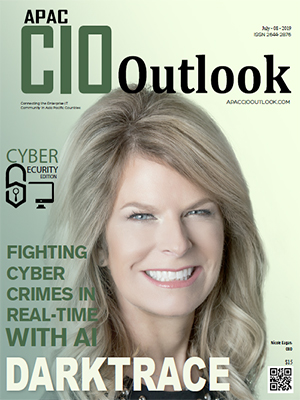Top 10 Cyber Security Service Providers - 2019 The Asia Pacific region is making great strides in digital transformation. Many economies are seeing the benefits of these significant developments like the Internet of Things (IoT) and cloud computing are becoming common in organizations. The transformation is also driven by the fact that employees are working remotely and flexibly—as more devices are connected to the internet than ever before. While this has opened up avenues for growth and development, it provides more vulnerability from threats and risks to businesses. That being said, attackers are getting increasingly sophisticated and are employing cutting-edge techniques to breach organizations.
As organizations continue their digital transformation, information risk becomes a significant component of their operational risk portfolios. In the past, these were treated as two separate elements. But that’s changing, in large part due to the increased instrumentation and actuation brought about by the IoT, the automated decision making of machine learning, and the digital value exchanges made possible by blockchain. As a result, organizations can no longer think of information security and operational risk as two separate things.
Organizations must seek assistance from cybersecurity services providers to implement first-line-of-defense tools that can scale, such as cloud security platforms and adopting next-generation endpoint process monitoring tools. The shift in security investments from threat prevention to threat detection requires an investment in security operations centers (SOCs) as the complexity and frequency of security alerts grow. The access of real-time, accurate threat intelligence data and processes will allow businesses to intercept the threat and risks ahead of time. Backing up data often and testing restoration procedures process are critical in today’s dynamic world of network-based ransomware and malware threats. By performing data analysis organizations will be better to determine an accurate assessment of the risks and use it, to incorporate the information into necessary security protocols and measures.
In addition, the market for security products, once dominated by a small number of suppliers, has grown more crowded. With prices for security products dropping, organizations need to ensure they’re not overpaying. Managers should review their current contracts and look for opportunities to save capital-investments, as prices may have come down since the contract was signed. Another factor driving prices downward are free-flowing funding from venture capital firms.
Standards groups, industries, and governments are constantly implementing new security policies. We expect to see governance and compliance, playing an increasingly important role in how organizations manage their risk profile in 2019. As policymakers work to address these authentication issues, they will need to adopt solutions that move away from the shared secret model while also being easy for consumers and employee to use. However, no technology or standard can eliminate the risk of a cyberattack, but the adoption of modern standards that incorporate into a business can be an important step in reducing cyber risk.
This edition of CIO Outlook brings you the “Top 10 Cyber Security Consulting/Services Companies -2019.” This list gives you some of the most prominent organizations in the industry that have excelled with their services portfolio in the enterprise risk management space. This list is aimed at bridging the gap between businesses and consulting/service providers that are transforming business processes through their insights and technological prowess.
THANK YOU FOR SUBSCRIBING

Top 10 Cyber Security Consulting/Services Companies - 2019

Nominate a Company
Usually, the qualified subscribers of our magazine nominate companies with whom they have collaborated and experienced exceptional results to be in this list. Did a company you recently worked with give you stellar results and ROI? Did it turn out to be one you would wholeheartedly recommend to peers? Or do you know of such an outstanding company through your network? Please fill in the details below and nominate them to be featured here.
*
Thank You!

We are glad to receive your nomination. Our editorial team and evaluation panel will review your submission. Thank you for taking the time to highlight an organization driving impactful change in APAC CIOOutlook.
Data not inserted
-
Ascendsys is an information security service provider that facilitates information security solutions to complex ICT environments
-
Digicentre, a cybersecurity service provider, helps organizations protect both their corporate and personal data by leveraging AI and other modern technologies to monitor hackers’ activities and provide early warnings of security breaches. The Taiwan-based company offers a wide range of network infrastructure services and comprehensive security capabilities that satisfy even the most demanding information security requirements. Digicentre started out as the IT and security department of Gamania—a Taiwanese gaming company—before becoming an independent subsidiary. Digicentre has also developed an in-house anti-hacking service for mobile apps that offers anti-reverse engineering, anti-app tampering, and encrypted data storage
-
Wontok delivers proven data security solutions that are simple to implement, non-intrusive, and fill the gaps left by conventional security offerings
-
AhnLab

AhnLab develops industry-leading cyber security solutions and services for enterprises, consumers, and small and medium businesses worldwide. They have a comprehensive security lineup, including proven antivirus products for servers and desktops, online transaction security products, mobile security products, network security appliances, and consulting services. Based on their cloud computing strategy, the company's technologies and solutions seamlessly converge into a unified platform to subsist with evolving IT security challenges. They deliver coordinated, and comprehensive protection against the broad variety of threat sources, due to consistently high quality at every level of their security strategy
-
Chaitin Technology

Chaitin Tech is a cybersecurity services provider based in China that leverages the latest technology to provide intelligent and simple cybersecurity solutions and advice to enterprises. The company released Next Generation Web Application Firewall (NGWAF) based on intelligence and semantic algorithms that enables enterprises to enhance their protection against cyber threats. Penetration testing, emergency response, code review and baseline inspection are some of the services that Chaitin Tech offers its clients. The company also ensures application security with measures such as SafeLine Next Gen Web Application Firewall, D-Sensor Intranet Threat Awareness System, CloudWalker Server Security Platform.
-
FirstWave Cloud Technology

FirstWave is a cybersecurity services provider. The company deploys safety through the most accessible and adaptive cloud-based cyber-security solutions making it affordable, easy, and fast to implement and enables security as a service. The machine learning and API technologies are used to automate, accelerate and optimize cloud-security delivery, threat protection, and security management. The company integrates security products from Cisco, Palo Alto Networks, and Fortinet into their cloud security platform, enabling the delivery of white labeled cloud security services through global cloud service providers like telecommunication companies. This unique proprietary cloud platform orchestration is available for service providers and enterprises of any size, anywhere.
-
LogRhythm

LogRhythm is a cybersecurity services provider and uses NextGen SIEM, empowering organizations on six continents to successfully reduce risk by rapidly detecting, responding to and neutralizing damaging cyberthreats. The LogRhythm platform combines user and entity behavior analytics, network traffic and behavior analytics, and security automation and orchestration in a single end-to-end solution. The Threat Lifecycle Management framework serves as the foundation for the AI-enabled SOC, helps customers secure their cloud, physical, and virtual infrastructures for both IT and OT environments. LogRhythm provides support level options and enables access to highly trained, experienced support staff who are focused on resolving security intelligence challenges.
-
Penten

Penten is a cybersecurity service firm that believes in mobility increasing the effectiveness of sensitive information and diverse thinking being the key to cyber defence, and all the problems can be solved by a motivated and skilled team of engineers. The company was founded by Australian technology entrepreneurs with a track record of successful commercialisation and innovation. They work closely with customers to gain deep insights and seek to solve their complex problems. The founders have built several successful and award-winning businesses, proving their prowess in the field. Founded as a start-up, Penten is now 40 people strong. They provide secure mobility, cyber deception, and cyber engineering.
-
SentinelOne

SentinelOne is a cybersecurity services provider that was formed by a group of defense and intelligence experts. They saw the market is in need of a robust cybersecurity solution as the traditional approaches failed to provide sufficient protection. SentinelOne aims to develop a dramatic new strategy to ensure endpoint protection, which applies AI and machine learning to stop known and unknown threats. Their team understands the endpoints value, as the attackers can interfere with the privacy, steal intellectual property, damage the infrastructure. To avoid this, SentinelOne team is dedicated to keeping its platform ahead of threats in any sector.
-
Tufin

Tufin is a cybersecurity services provider that orchestrates and manages security policies across physical networks and cloud platforms. The company enables customers to increase their business agility, while maintaining a robust security posture across physical networks, hybrid cloud, containers, and microservices. Tufin provides policy-based automation to help customers implement changes in minutes with proactive risk analysis and continuous policy compliance. The company improves security by eliminating attack vectors and allows collaboration between application owners, network engineers, and security teams. Tufin serves over 2,000 customers spanning all industries and geographies with its patent-protected products and technologies.
Top Cyber Security Consulting/Services Companies
I agree We use cookies on this website to enhance your user experience. By clicking any link on this page you are giving your consent for us to set cookies. More info


















